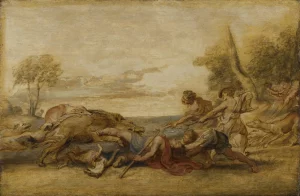Humans are far from perfect, so the decisions we sometimes make aren’t as set in stone as we think. And the Princeton University Art Museum found this out recently. Its curators attributed a small oil-on-panel work to the Flemish Old Master painter Peter Paul Rubens, even though the museum had already stripped the work of such an attribution close to thirty years ago.
The Death of Adonis is a small oil sketch showing a wild boar attacking the titular Greek mythological figure. The story goes that Adonis bled to death in the arms of his lover Aphrodite, whose tears combined with his blood, causing anemone flowers to sprout wherever they dropped. The work is dated to 1639 and is not the first time Rubens depicted the mythic scene. His most famous take on the story came in 1614, with a large oil painting now kept by the Israel Museum in Jerusalem. The Princeton Museum acquired the oil sketch in 1930 when one of the curators purchased it from Charles Sackville-West, an English baron whose sister Vita was an author and paramour to Virginia Woolf. The museum initially attributed the work to Rubens partially based on its inclusion in an inventory compiled by Rubens’s chief assistant, Jan Wildens. Hermann Gluck of the National Museum in Vienna also aided Princeton curators in their attribution.
The oil sketch lost its Rubens attribution sometime in the 1990s and has since been labeled as “formerly attributed to Peter Paul Rubens”. However, curator Ronni Baer and chief conservator Bart Devolder decided to revisit the subject while restoring the panel in 2019. Skepticism regarding the positive Rubens attribution likely stems from the 1947 article “Rubens in America” by the art historian Julius Held and the writer Jan-Albert Goris. They believed that Death of Adonis is a copy of an original by Rubens since it lacks “the rhythmic force of the master”. However, Held was known to have changed his mind several times about the work. In 1980, Held wrote in a Princeton catalogue on Rubens’s oil sketches, “Contrary to my previously published opinion, I am not convinced that the Princeton sketch is the original one.”
Attributing a work to Rubens is a notoriously difficult task. Like some other Old Masters, Rubens rarely signed any of his works. He also employed any number of assistants and apprentices in his studio at a time. This means that Rubens was far from the only one with a hand in his final works. Furthermore, one of the defining catalogue raisonnés of his work is the Corpus Rubenianum, compiled by the German art historian Ludwig Burchard, which catalogues over 1,100 works by Rubens across twenty-six volumes. However, following his death in 1960, the truth came out that Burchard had exchanged attributions for cash for around sixty works, including the infamous Samson & Delilah at the National Gallery in London, which is considered a fake or a copy by some. Regardless, thanks to revisions made by other art historians, the Corpus Rubenianum is still considered one of the top works in the field of Rubens' scholarship. However, scholars today are always wary of the risks of using the Burchard catalogue as a source.
Though there has been no official announcement, the Princeton University Art Museum recently changed Death of Adonis’s authorship to Rubens on its online catalogue. With ongoing renovations, the Princeton Museum plans to reopen with the Rubens on display by 2025.

